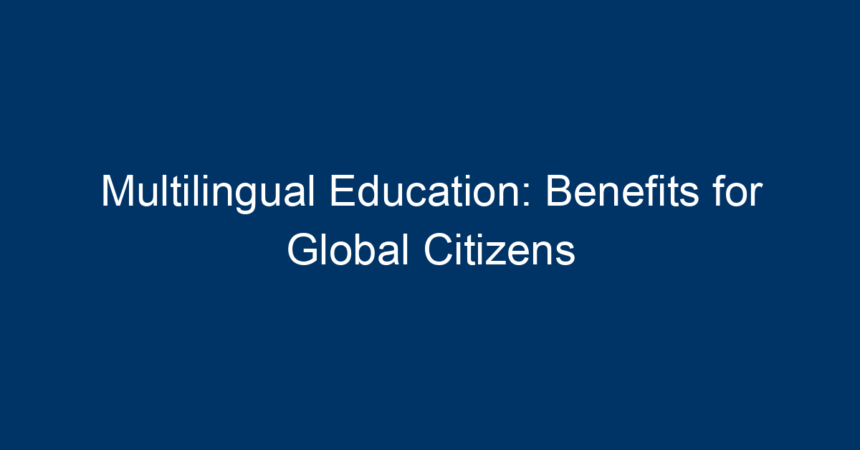In an increasingly interconnected world, the ability to communicate in multiple languages is not just a valuable skill—it’s essential. Multilingual education fosters this capability, equipping students with the linguistic tools they need to thrive in diverse environments. This approach not only enhances cognitive abilities but also builds cultural awareness, instilling in students the identity of global citizens. In this article, we will explore the many benefits of multilingual education, how it prepares individuals for real-world challenges, and actionable insights for educators, parents, and policymakers.
What is Multilingual Education?
Multilingual education refers to teaching strategies that involve the use of two or more languages in the classroom. This approach can take various forms, including:
- Dual Language Programs: Instruction is delivered in two languages, often balancing the linguistic proficiency for both.
- Content-Based Instruction: Subjects like science or math are taught in a target language.
- Immersion Programs: Students are immersed in a language-rich environment, encouraging natural language acquisition.
This educational philosophy recognizes the importance of language as a medium for learning, communication, and cultural expression. By embracing multilingual education, educational systems can better prepare students for future challenges.
The Cognitive Benefits of Multilingual Education
One of the most widely recognized advantages of multilingual education is its positive impact on cognitive development. Research has shown that bilingual individuals often outperform their monolingual peers in various cognitive tasks:
Enhanced Problem-Solving Skills
Learning multiple languages helps students develop superior problem-solving skills. They become adept at approaching situations from various angles, making them more versatile thinkers.
Improved Memory
Multilingual individuals generally exhibit better memory capacity. The challenge of switching between languages improves working memory, which is beneficial across all academic disciplines.
Greater Creativity
Exposure to diverse languages and cultures fosters an environment rich in creativity. Multilingual students often demonstrate a broader range of ideas and more innovative solutions, thanks to their varied linguistic experiences.
Cultural Awareness and Empathy
Building Global Citizens
Multilingual education supports the cultivation of cultural awareness, which is essential for becoming a global citizen. Students gain insights into different cultures, traditions, and worldviews. This understanding promotes empathy and respect for others, essential qualities in our increasingly globalized society.
Encouraging Diversity and Inclusion
A multilingual classroom is often a microcosm of a diverse society. By engaging with various cultures and languages, students learn to appreciate diversity, which helps combat stereotypes and fosters a more inclusive atmosphere.
Opening Doors to Career Opportunities
Marketability in the Job Market
In today’s competitive job market, bilingualism or multilingualism is a valuable asset. Many employers seek candidates who can communicate with diverse clients or partners. Multilingual education provides students with a distinct advantage, making them more marketable.
Expanding Professional Networks
Proficiency in multiple languages allows individuals to connect with a broader range of people, significantly expanding their professional and social networks. These connections can lead to job opportunities and collaborations that would otherwise be out of reach.
Language Proficiency and Academic Success
Improved Academic Performance
Studies consistently show that students participating in multilingual education programs perform better academically. They exhibit enhanced reading and writing skills, not just in their native language but also in their second or third languages. This academic success can be attributed to improved cognitive abilities and a deeper understanding of linguistic structures.
Lifelong Learning
Multilingual education instills a love for languages that often continues beyond the classroom. Students who learn languages early tend to be more inclined to pursue language learning throughout their lives, fostering continuous personal and professional growth.
Support Systems for Multilingual Education
Role of Educators
Teachers play a crucial role in implementing effective multilingual education programs. Educators need specialized training to create an engaging environment that promotes language learning while respecting the cultural identities of all students.
Involvement of Parents and Communities
Parents and local communities can bolster multilingual education initiatives by promoting language learning at home and providing resources. Involvement in cultural events and language programs can enhance the educational experience for students.
Challenges of Multilingual Education
While the benefits of multilingual education are vast, there are inherent challenges that must be addressed:
Resource Allocation
Implementing multilingual education requires significant resources, including trained teachers, instructional materials, and curriculum development. Policymakers need to prioritize funding and strategies that support these initiatives.
Standardization and Assessment
Creating a standardized assessment for multilingual education can be tricky. Traditional assessments may not accurately reflect a student’s capabilities in multiple languages. As such, methodologies for evaluation must evolve to cater to diverse linguistic abilities.
Actionable Insights for Implementing Multilingual Education
For Educators
- Adopt a Flexible Curriculum: Use varied teaching methods and resources to accommodate different learning styles and language proficiencies.
- Engage in Professional Development: Participate in workshops and training sessions focused on multilingual teaching techniques and cultural competency.
For Parents
- Encourage Language Learning at Home: Use multi-language resources such as books, apps, and websites to promote language practice.
- Participate in Cultural Exchange Programs: Engage in community events that celebrate cultural diversity, helping reinforce your child’s language skills.
For Policymakers
- Advocate for Funding: Promote resource allocation for multilingual programs, ensuring schools have the necessary tools for success.
- Develop Comprehensive Assessment Tools: Work on creating assessments that accurately measure proficiency across multiple languages.
Conclusion
Multilingual education is not just a trendy approach; it’s a transformative philosophy that prepares students to thrive in an interconnected world. The cognitive, cultural, and economic benefits are clear—students who engage in multilingual education tend to excel academically, embrace diversity, and position themselves as competitive players in the job market. By recognizing the immense value of multilingual education and implementing strategic measures, we can cultivate a generation of global citizens who are ready to face the challenges of the future.
Embrace multilingual education today, and empower the leaders of tomorrow.



